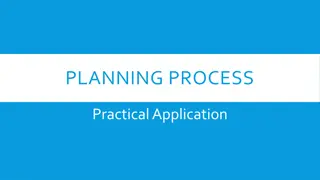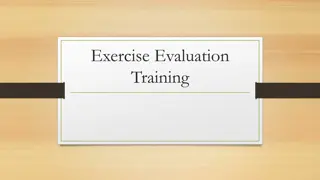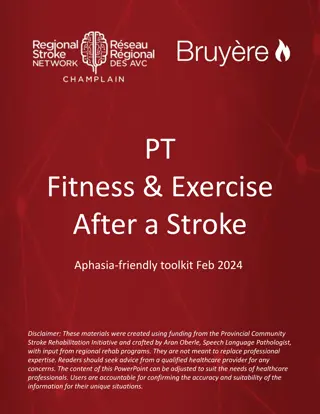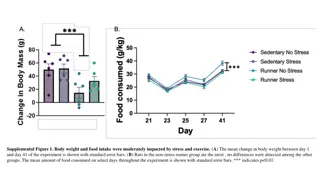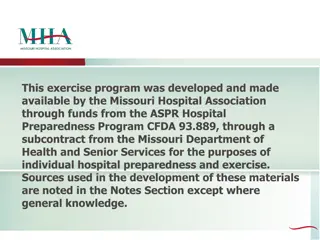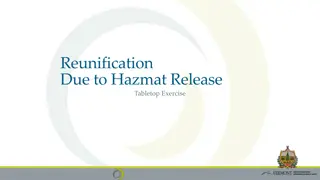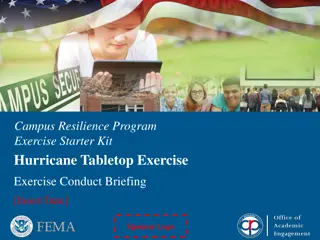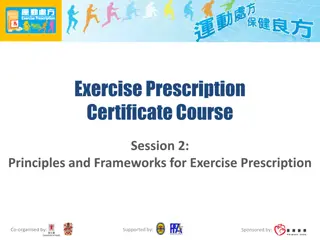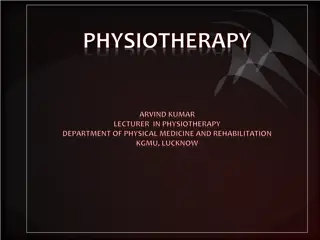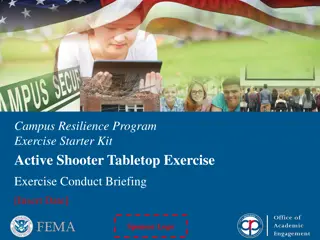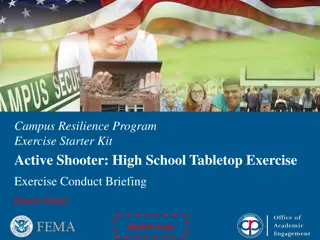Exercise Control System and Tools for Operations-Based Exercises
This unit delves into the intricacies of the Simulation Cell (SimCell) structure, controllers' roles, inject delivery options, and exercise control systems. It emphasizes the importance of communication, coordination, and proficiency in maintaining a safe and effective exercise environment. The control structure, decision tracking systems, and inject tracking tools play pivotal roles in managing exercise scenarios and player responses. Efficient SimCell control is highlighted as critical for maintaining the pace of exercise play. The unit invites discussions on experience with inject tracking systems to enhance understanding and proficiency in exercise control.
Download Presentation

Please find below an Image/Link to download the presentation.
The content on the website is provided AS IS for your information and personal use only. It may not be sold, licensed, or shared on other websites without obtaining consent from the author.If you encounter any issues during the download, it is possible that the publisher has removed the file from their server.
You are allowed to download the files provided on this website for personal or commercial use, subject to the condition that they are used lawfully. All files are the property of their respective owners.
The content on the website is provided AS IS for your information and personal use only. It may not be sold, licensed, or shared on other websites without obtaining consent from the author.
E N D
Presentation Transcript
E133: OPERATIONS-BASED EXERCISE DESIGN AND EVALUATION COURSE Unit 3: Exercise Control System (ECS) and Proficiency Demonstration #1 FEMA News Photo 3.1
Unit Objectives By the end of this unit you will be able to: Describe the Simulation Cell (SimCell) structure, including staff, communication, and setup Describe the roles and responsibilities of controllers and simulators Describe options for inject delivery Describe the lifecycle of an inject in a simulated operations-based exercise 3.2
Exercise Control The control structure for an operations-based exercise describes how controllers communicate and coordinate with one another and how they track exercise information These procedures should be detailed in the C/E Handbook During exercise play, controllers carry out these responsibilities and closely monitor exercise play to ensure a safe and effective exercise 3.3
Exercise Control (contd.) Exercise control synchronizes: Control staff structure Exercise scenario Inject delivery Player responses FEMA News Photo 3.4
Exercise Control (contd.) During FE play, SimCell control is particularly important FEs require a robust and detailed MSEL and close communication between the site controller(s) and the SimCell Controllers should advise the SimCell on the pace of exercise play, and request more or fewer injects as necessary to maintain an appropriate pace 3.5
Tools for Exercise Control Resource/decision tracking system Means of keeping track of the decisions made and the resources available or dispatched/deployed Inject tracking system Ensures injects are reaching their destination and players/controllers are appropriately closing the loop 3.6
Tools for Exercise Control (contd.) Who has experience with an inject tracking system? What kind of system did you use? Discussion 3.7
What Is a SimCell? HSEEP: A SimCell is used to generate injects for, receive player responses for, and provide information in place of nonparticipating organizations that would likely participate actively if exercise events were real. Physically, the SimCell is a working location for a number of qualified professionals who portray these nonparticipating organizations. 3.8
SimCell Staff Controllers and simulators Both deliver planned injects or create new injects to prompt player actions FEMA News Photo 3.9
SimCell Staff (contd.) Senior Controller: All controllers should be accountable to one Senior Controller Primary responsibility is to manage the delivery of the disaster to the players Also responsible for the overall organization of the exercise 3.10
SimCell Staff (contd.) Senior Controller (cont d.): Monitors actions by controllers and exercise progress Coordinates decisions regarding deviations or significant changes to the scenario caused by unexpected developments during play Debriefs controllers and evaluators after the exercise Oversees the setup and takedown of the exercise 3.11
SimCell Staff (contd.) Controllers: Plan and manage exercise play Set up and operate the exercise incident site Take the roles of individuals and agencies not actually participating in the exercise, if necessary Have the authority to modify or control the exercise per direction from the Senior Controller Communicate identified issues to the Senior Controller in regard to pace, key events, player activities, etc. 3.12
SimCell Staff (contd.) Controllers (cont d.): Monitor the pace of exercise play Provide key data to players Prompt or initiate certain player actions and injects to the players as described in the MSEL to ensure exercise continuity, if necessary Provide exercise materials to players as required Monitor the exercise timeline Supervise the safety of all exercise participants 3.13
SimCell Staff (contd.) Controllers (cont d.): Must be able to view the exercise as a whole and to think quickly on his or her feet Are the only participants who should provide information or direction to players Are the only participants the players should reach out to if they have questions about the exercise conduct expectations and mechanics 3.14
SimCell Staff (contd.) Simulators: Are control staff personnel who role play as nonparticipating organizations or individuals Most often operate out of the SimCell, but they may occasionally have face-to-face contact with players Function semi-independently under the supervision of the Lead Simulator, enacting roles in accordance with instructions provided in the MSEL Are ultimately accountable to the Exercise Director and Senior Controller 3.15
SimCell Staff (contd.) Simulators (cont d.): Administer the exercise scenario (deliver the disaster!) Introduce injects that represent events, resource requests, critical information, etc. Respond to players feedback on decisions made and actions taken Simulate reality external to the player in the response arena Serve as relay to the players, informing them of everything that occurs in the field Develop the inject tracking system (Lead Simulator) 3.16
SimCell Staff (contd.) Simulators (cont d.): May be required to think on the fly, develop new information, and ad lib injects as needed therefore the SimCell must stay in communication with the Senior Controller, and must immediately inform controllers of any actual or potential deviations from the planned scenario or MSEL Use the MSEL to know when an inject/communication should be sent to the players, but not deliver injects until directed by the Lead Simulator Should be familiar with the organizations they are simulating 3.17
SimCell Staff (contd.) The general roles of the SimCell staff include everything the players are not: All field personnel and equipment Agencies, departments, individuals not physically in the player areas Private companies and resources needed for the emergency All citizens of the community 3.18
SimCell Staff (contd.) For MEPP purposes, the specific roles within the SimCell should represent the whole community: Government (G) Media/Public Information (M) Emergency Management (EM) Law Enforcement (LE, P, S/SP) Fire Service (F) Health and Medical (EMS, PH, H) Public Works/Utilities (PWU) Community/Human Services (CS) Concerned citizens and others (CC) 3.19
SimCell Staff (contd.) Government (G) Mayors County Commissioners/Supervisors City/County Managers Finance Directors Human Resource Directors City/County attorneys Other elected officials Public administration Functions (i.e., management players) 3.20
SimCell Staff (contd.) Media/Public Information (M) Public affairs officers Departmental public information officials Citizen information centers Media affairs officials Local/national media outlets (print, radio, and video) Social media 3.21
SimCell Staff (contd.) Emergency Management (EM) Emergency Managers Public Safety Directors Risk Managers National Guard Military Information Technology Geographic Information System (GIS) FEMA News Photo 3.22
SimCell Staff (contd.) Law Enforcement (P, LE, S/SP) Police departments Sheriff s offices State police/patrols Federal law enforcement agencies (e.g., FBI, ATF, CBP) Other security resources FEMA News Photo 3.23
SimCell Staff (contd.) Fire Service (F) Fire departments Fire Marshals HAZMAT Fire prevention Industrial fire brigades U.S. Forestry Service FEMA News Photo 3.24
SimCell Staff (contd.) Health and Medical (EMS, PH, H) Emergency medical services (EMS) Public health (PH) Environmental health Epidemiology Hospitals (H) Health care providers Mental health 3.25
SimCell Staff (contd.) Public Works/Utilities (PWU) Public Works departments Streets and traffic engineering Water and sewer Gas and electric Sanitation services Building and ground maintenance Code administration FEMA News Photo 3.26
SimCell Staff (contd.) Community/Human Services (CS) Social service agencies Public housing authority Public transportation services Schools and universities Volunteer agencies, etc. Faith-based organizations Civic and professional associations Animal advocate groups Community Organizations Active in Disasters (COAD) Voluntary Organizations Active in Disasters (VOAD) 3.27
SimCell Staff (contd.) Concerned citizens and others (CC) All businesses, all citizen groups Can be handled by any controller/simulator Specialized groups (Girl Scouts, Boy Scouts) 3.28
SimCell Communication (contd.) Players must contact the SimCell to: Deploy any and all equipment Order supplies or materials Request mutual aid Disseminate information to field personnel Find out what is going on in the field Get a description of the incident Bottom line: If a needed resource is NOT physically participating in the exercise, players must contact the SimCell to acquire it 3.30
SimCell Communication (contd.) Communication directory: Before the exercise, develop a directory that contains: Telephone and fax numbers Radio frequencies/talk groups Communications procedures 3.31
SimCell Setup The SimCell setup should be large enough to hold all participants and allow simulators to contact players in the way they would typically receive and send information Ensure all means of communications are working properly, including: Telephones Radios Computers/Internet Email Texting Social media sites Fax machines 3.32
Inject Flow 3.33
Inject Flow (contd.) To be as realistic as possible, real-time will typically be utilized during a functional exercise Skip-time elements should typically not be introduced during an exercise If you must implement a skip-time, do it overnight during a multi-day exercise 3.34
Inject Delivery Use various means of communication between and among players and SimCell, including: Verbal Telephone Radio Fax Computer/Internet Clearly identify all communication as exercise- related Email Texting Social media Television/video 3.35
Inject Delivery (contd.) What are other means of communication you use in your jurisdiction during exercises? Discussion 3.36
Panel Discussion: SimCell Best Practices 3.37
Unit Summary In this unit you learned: About SimCell staff, communication, and setup About the roles/responsibilities of controllers and simulators About exercise control About inject flow and the lifecycle of an inject SimCell best practices 3.38
Questions? 3.39
Proficiency Demonstration #1: SimCell 3.40
Proficiency Demonstration #1: SimCell Proficiency Demonstration Instruction Sheets: Are located in Participant Guide (PG) Provide all of the instructions and information needed for completing the Proficiency Demonstration, including all the information that is about to be presented on the slides Take the instruction sheets with you when you go to your breakout rooms Provided for every Proficiency Demonstration Visual 3.41
Proficiency Demonstration #1: SimCell (cont d.) Purpose: Apply ECS concepts and principles in a SimCell environment Total time: 3 hours 10 minutes to tour SimCell and EOC rooms 1 hour to prepare for the functional exercise 1 hour 20 minutes to conduct the functional exercise (two 40-minute rounds) 20 minutes for peer/instructor feedback 10 minutes for internal group feedback 3.42
Proficiency Demonstration #1: SimCell (cont d.) Scenario: You will participate in a functional exercise as a SimCell staff member either a controller or simulator You will conduct the functional exercise with another group who will be acting as the players, specifically, members of the Emergency Operations Center (EOC) 3.43
Proficiency Demonstration #1: SimCell (cont d.) Scenario (cont d.): There will be two rounds of exercising, with the first round addressing the first half of the exercise injects and the second round addressing the second half of the injects: Round 1: Group 1 is SimCell, Group 3 is players Round 1: Group 2 is SimCell, Group 4 is players Round 2: Group 3 is SimCell, Group 1 is players Round 2: Group 4 is SimCell, Group 2 is players 3.44
Proficiency Demonstration #1: SimCell (cont d.) Functional Exercise Roles: Each group will need to select their roles for the FE. Select from the roles provided on the telephone directory: If your group is the SimCell, designate the SimCell roles, including Senior Controller If your group is the EOC, designate the EOC roles Do not deviate from the roles provided on the phone list. Don t delete or add roles to phone list. If the role is not on the list, don t assign it. 3.45
Proficiency Demonstration #1: SimCell (cont d.) Functional Exercise Preparation (prepare for both roles: SimCell and EOC): Tour the SimCell and EOC rooms with your instructor Do your preparation work in the room in which your group will be starting Complete a communications check Review the MSEL (there are errors that need to corrected) Review the Controller Notes Review the telephone directories 3.46
Proficiency Demonstration #1: SimCell (cont d.) Functional Exercise Preparation (cont d.): When your group is the SimCell: Designate the SimCell roles, including Senior Controller Develop a method to track resources and decisions Senior Controller: Develop an inject tracking system If your group is the EOC: Designate the EOC roles NOTE: A list of exercise roles/responsibilities is provided in Handout 3-1 Exercise Roles and Descriptions 3.47
Proficiency Demonstration #1: SimCell (cont d.) Tips for All Participants: Roll with the exercise don t fight it You don t need to agree with the events in the MSEL, how other players react, etc. The goal of this exercise is to illustrate how a SimCell works, and therefore, it may not always be in line with a real life functional exercise Your Senior Controller may temporarily halt the SimCell activity be prepared for this interruption in exercise flow 3.48
Proficiency Demonstration #1: SimCell (cont d.) Tips for SimCell Members: Don t feel overwhelmed, the instructor is there to work with you Keep accurate notes on resource decisions made, particularly if you re the SimCell in the first round, because the next SimCell needs to know the status of resources and decisions Controllers need to ensure contingency injects aren t put in without the Senior Controller s approval/ go ahead 3.49
Proficiency Demonstration #1: SimCell (cont d.) Tips for EOC Members: Follow along in the MSEL Keep track of the exercise progression After completion of the Proficiency Demonstration, return to the plenary classroom for a group discussion. 3.50



